
A periscope for gene therapy: How high-resolution methods like single-cell sequencing may help predict the fate of gene therapy drug product
In recent years, tools that enable deeper analysis of single cells have made incredible progress. We can now look at individual cells from a single sample and see how they differ from one another in terms of their DNA, gene expression and protein production. With these tools, each cell tells its own story about where it has been, what it is doing in the moment and how it is likely to evolve in the future.
Understanding how individual cells respond to their environment and change over time is increasingly of interest – and even becoming a necessity – in advanced therapies. With patient safety always at the forefront in gene therapy, coupled with the need to show long-term, durable expression with one-time therapies, the space is ripe for in-depth data at the singular cell level that can assess safety and stability with utmost precision.
The leap to industry
For a number of years now, single cell sequencing has transformed academic researchers’ ability to better understand the diversity and dynamics of cells. It is now time to broaden the technology’s application to biotech drug discovery and development. Using single-cell analysis and FACS sorting combined with integration site analysis, we can map the fates of cells before, during and after gene therapy treatment, producing insights that can help shape future therapeutic innovation.
At AVROBIO, we are using these two cutting-edge techniques to monitor our investigational gene therapies at the cellular level to provide a new level of detail on therapeutically modified hematopoietic stem and progenitor cells as they differentiate and integrate throughout the body; it is detail that would otherwise be unavailable using standard industry practices. We are currently trying to better understand the nature of the cells we are infusing back into the patient in terms of both durability and safety, the two most important factors in a gene therapy’s success outside of potency. In single cell sequencing, we now have a powerful and granular tool that potentially enables us to track the differentiation and expansion of modified cells over time.
Probing durability and safety
From a durability perspective, our goal is to see a stable population of CD34+ stem cells preserved in patients’ bone marrow for a long period after treatment. Single cell analysis potentially allows us to not only characterize the initial population of CD34+ cells collected to create our drug product, but also to track their differentiation through production, infusion and for years afterward. This analysis could enable us to see how many of our CD34+ stem cells have taken up residence in a patient’s bone marrow and to estimate with a certain degree of confidence how many stem cells we need to begin with, in order to produce a given stable population percentage.
Our high-resolution approach also has the potential to shed light on safety. Transduction of the therapeutic gene has a small probability of introducing clonal stress to a stem cell, causing it to proliferate in a malignant fashion. AVROBIO has developed a new approach involving high-resolution molecular biology follow-up that is designed to enable the collection and monitoring of integration sites for individual cell types and at different stages of cell maturation. Knowing when and how such events may occur could provide valuable insight.
Analyzing integration sites broadly across a patient’s white blood cells, which is the standard industry practice, provides valuable but insufficient information about the potential for clonal expansion events. Although there is value to observing whether transduced genes are landing in parts of the genome that may cause them to drive unwanted growth, we can also use these integration sites as “barcodes” to trace how individual hematopoietic progenitor cells expand and differentiate into daughter cell types. This degree of resolution may allow us to capture potential events of concern earlier and draw focus to specific sub-populations. The information also has the potential to characterize the diversity of daughter cells, showing the degree to which transduced cells have spawned differentiated populations of T cells, B cells, monocytes and all the other blood cell types.
Deep understanding
While it is fair to question the need for this level of detail, at AVROBIO we believe it is important to be proactive instead of reactive when it comes to understanding how our gene therapies work. Patient safety is at the core of our work. We’re on a mission to use our scientific periscope to collect information that has never previously been collected, at the highest resolution.
Our ultimate goal is not to perform single cell sequencing routinely on all patients, but to get to the point where we better understand how our gene therapies work down to the cellular level, across the range of anticipated applications. We believe that information will advance our mission of freeing people from a lifetime of genetic disease.